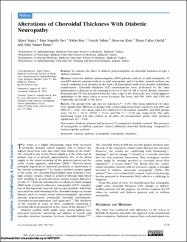Alterations of choroidal thickness with diabetic neuropathy

Göster/
Erişim
info:eu-repo/semantics/openAccessAttribution‐NonCommercial‐NoDerivs 3.0 United Stateshttp://creativecommons.org/licenses/by‐nc‐nd/3.0/us/Tarih
2016Yazar
Yazıcı, AlperSarı, Esin Söğütlü
Koç, Emine Rabia
Şahin, Gözde
Kurt, Hüseyin
Özdal, Pınar Çakar
Ermiş, Sıtkı Samet
Üst veri
Tüm öğe kaydını gösterÖzet
PURPOSE. To evaluate the effect of diabetic polyneuropathy on choroidal thickness in type 2 diabetes patients. METHODS. Forty-one diabetic polyneuropathy (DPN) patients with no or mild retinopathy, 50 non-DPN diabetic patients with no or mild retinopathy, and 42 healthy controls without any retinal complaint were included in the study. All participants underwent detailed ophthalmic examinations. Choroidal thickness (CT) measurements were performed by the same independent technician in the morning between 9 and 11 AM to avoid diurnal variations. Perpendicular CT was measured from the outer edge of the hyperreflective retinal pigment epithelium to the inner sclera at seven locations: the fovea; and 500, 1000, and 1500 mu m temporally and nasally to the fovea. RESULTS. The groups were age and sex matched (P > 0.05). The mean subfoveal CT values were significantly different in groups with a thickening trend from control to non-DPN and DPN (P < 0.01). The mean values for subfoveal CT in control, non-DPN, and DPN groups were 241.12 +/- 52.71, 279.82 +/- 51.42, and 304.71 +/- 54.92 mu m, respectively. The same thickening trend was also evident in all other six measurement points with statistical significance (P < 0.01). CONCLUSIONS. Diabetic patients had increased CT compared to healthy controls. The presence of neuropathy in diabetes patients caused additional choroidal thickening, compared to nonneuropathic patients.


















